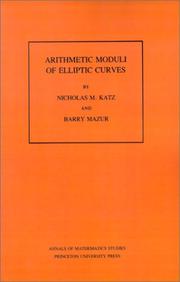| Listing 1 - 4 of 4 |
Sort by
|
Book
ISBN: 2040017070 9782040017071 Year: 1975 Publisher: Paris : Gauthier-Villars,
Abstract | Keywords | Export | Availability | Bookmark
 Loading...
Loading...Choose an application
- Reference Manager
- EndNote
- RefWorks (Direct export to RefWorks)
512 --- Noncommutative algebras --- Modules (Algebra) --- Noetherian rings --- Rings, Noetherian --- Associative rings --- Commutative rings --- Finite number systems --- Modular systems (Algebra) --- Algebra --- Finite groups --- Rings (Algebra) --- Algebras, Noncommutative --- Non-commutative algebras --- Noetherian rings. --- Noncommutative algebras. --- Modules (Algebra). --- 512 Algebra --- Algèbres non commutatives --- Algèbres non commutatives.

ISBN: 0691083525 0691083495 1400881714 Year: 1985 Publisher: Princeton, N.J.
Abstract | Keywords | Export | Availability | Bookmark
 Loading...
Loading...Choose an application
- Reference Manager
- EndNote
- RefWorks (Direct export to RefWorks)
This work is a comprehensive treatment of recent developments in the study of elliptic curves and their moduli spaces. The arithmetic study of the moduli spaces began with Jacobi's "Fundamenta Nova" in 1829, and the modern theory was erected by Eichler-Shimura, Igusa, and Deligne-Rapoport. In the past decade mathematicians have made further substantial progress in the field. This book gives a complete account of that progress, including not only the work of the authors, but also that of Deligne and Drinfeld.
Curves, Elliptic --- Moduli theory --- Theory of moduli --- Functions of several complex variables --- Elliptic curves --- Curves, Algebraic --- Geometry, Algebraic --- 511.3 --- Analytic spaces --- Algebraic geometry --- Geometry --- 511.3 Analytical, additive and other number-theory problems. Diophantine approximations --- Analytical, additive and other number-theory problems. Diophantine approximations --- Ordered algebraic structures --- Curves, Elliptic. --- Moduli theory. --- Geometry, Algebraic. --- Abelian variety. --- Addition. --- Algebraic variety. --- Algebraically closed field. --- Ambient space. --- Arithmetic. --- Axiom. --- Barry Mazur. --- Base change. --- Calculation. --- Canonical map. --- Change of base. --- Closed immersion. --- Coefficient. --- Coherent sheaf. --- Cokernel. --- Commutative property. --- Congruence relation. --- Coprime integers. --- Corollary. --- Cusp form. --- Cyclic group. --- Dense set. --- Diagram (category theory). --- Dimension. --- Discrete valuation ring. --- Disjoint union. --- Divisor. --- Eigenfunction. --- Elliptic curve. --- Empty set. --- Factorization. --- Field of fractions. --- Finite field. --- Finite group. --- Finite morphism. --- Free module. --- Functor. --- Group (mathematics). --- Integer. --- Irreducible component. --- Level structure. --- Local ring. --- Maximal ideal. --- Modular curve. --- Modular equation. --- Modular form. --- Moduli space. --- Morphism of schemes. --- Morphism. --- Neighbourhood (mathematics). --- Noetherian. --- One-parameter group. --- Open problem. --- Prime factor. --- Prime number. --- Prime power. --- Q.E.D. --- Regularity theorem. --- Representation theory. --- Residue field. --- Riemann hypothesis. --- Smoothness. --- Special case. --- Subgroup. --- Subring. --- Subset. --- Theorem. --- Topology. --- Two-dimensional space. --- Zariski topology.

ISBN: 0691081018 9780691081014 140088179X 9781400881796 Year: 1971 Volume: 72 Publisher: Princeton (N.J.): Princeton university press
Abstract | Keywords | Export | Availability | Bookmark
 Loading...
Loading...Choose an application
- Reference Manager
- EndNote
- RefWorks (Direct export to RefWorks)
Algebraic K-theory describes a branch of algebra that centers about two functors. K0 and K1, which assign to each associative ring ∧ an abelian group K0∧ or K1∧ respectively. Professor Milnor sets out, in the present work, to define and study an analogous functor K2, also from associative rings to abelian groups. Just as functors K0 and K1 are important to geometric topologists, K2 is now considered to have similar topological applications. The exposition includes, besides K-theory, a considerable amount of related arithmetic.
Algebraic geometry --- Ordered algebraic structures --- Associative rings --- Abelian groups --- Functor theory --- Anneaux associatifs --- Groupes abéliens --- Foncteurs, Théorie des --- 512.73 --- 515.14 --- Functorial representation --- Algebra, Homological --- Categories (Mathematics) --- Functional analysis --- Transformations (Mathematics) --- Commutative groups --- Group theory --- Rings (Algebra) --- Cohomology theory of algebraic varieties and schemes --- Algebraic topology --- Abelian groups. --- Associative rings. --- Functor theory. --- 515.14 Algebraic topology --- 512.73 Cohomology theory of algebraic varieties and schemes --- Groupes abéliens --- Foncteurs, Théorie des --- Abelian group. --- Absolute value. --- Addition. --- Algebraic K-theory. --- Algebraic equation. --- Algebraic integer. --- Banach algebra. --- Basis (linear algebra). --- Big O notation. --- Circle group. --- Coefficient. --- Commutative property. --- Commutative ring. --- Commutator. --- Complex number. --- Computation. --- Congruence subgroup. --- Coprime integers. --- Cyclic group. --- Dedekind domain. --- Direct limit. --- Direct proof. --- Direct sum. --- Discrete valuation. --- Division algebra. --- Division ring. --- Elementary matrix. --- Elliptic function. --- Exact sequence. --- Existential quantification. --- Exterior algebra. --- Factorization. --- Finite group. --- Free abelian group. --- Function (mathematics). --- Fundamental group. --- Galois extension. --- Galois group. --- General linear group. --- Group extension. --- Hausdorff space. --- Homological algebra. --- Homomorphism. --- Homotopy. --- Ideal (ring theory). --- Ideal class group. --- Identity element. --- Identity matrix. --- Integral domain. --- Invertible matrix. --- Isomorphism class. --- K-theory. --- Kummer theory. --- Lattice (group). --- Left inverse. --- Local field. --- Local ring. --- Mathematics. --- Matsumoto's theorem. --- Maximal ideal. --- Meromorphic function. --- Monomial. --- Natural number. --- Noetherian. --- Normal subgroup. --- Number theory. --- Open set. --- Picard group. --- Polynomial. --- Prime element. --- Prime ideal. --- Projective module. --- Quadratic form. --- Quaternion. --- Quotient ring. --- Rational number. --- Real number. --- Right inverse. --- Ring of integers. --- Root of unity. --- Schur multiplier. --- Scientific notation. --- Simple algebra. --- Special case. --- Special linear group. --- Subgroup. --- Summation. --- Surjective function. --- Tensor product. --- Theorem. --- Topological K-theory. --- Topological group. --- Topological space. --- Topology. --- Torsion group. --- Variable (mathematics). --- Vector space. --- Wedderburn's theorem. --- Weierstrass function. --- Whitehead torsion. --- K-théorie

ISBN: 0691082383 1400883989 Year: 1980 Publisher: Princeton (N.J.): Princeton university press
Abstract | Keywords | Export | Availability | Bookmark
 Loading...
Loading...Choose an application
- Reference Manager
- EndNote
- RefWorks (Direct export to RefWorks)
One of the most important mathematical achievements of the past several decades has been A. Grothendieck's work on algebraic geometry. In the early 1960s, he and M. Artin introduced étale cohomology in order to extend the methods of sheaf-theoretic cohomology from complex varieties to more general schemes. This work found many applications, not only in algebraic geometry, but also in several different branches of number theory and in the representation theory of finite and p-adic groups. Yet until now, the work has been available only in the original massive and difficult papers. In order to provide an accessible introduction to étale cohomology, J. S. Milne offers this more elementary account covering the essential features of the theory. The author begins with a review of the basic properties of flat and étale morphisms and of the algebraic fundamental group. The next two chapters concern the basic theory of étale sheaves and elementary étale cohomology, and are followed by an application of the cohomology to the study of the Brauer group. After a detailed analysis of the cohomology of curves and surfaces, Professor Milne proves the fundamental theorems in étale cohomology -- those of base change, purity, Poincaré duality, and the Lefschetz trace formula. He then applies these theorems to show the rationality of some very general L-series.Originally published in 1980.The Princeton Legacy Library uses the latest print-on-demand technology to again make available previously out-of-print books from the distinguished backlist of Princeton University Press. These editions preserve the original texts of these important books while presenting them in durable paperback and hardcover editions. The goal of the Princeton Legacy Library is to vastly increase access to the rich scholarly heritage found in the thousands of books published by Princeton University Press since its founding in 1905.
Ordered algebraic structures --- 512.73 --- 512.66 --- Geometry, Algebraic --- Homology theory --- Sheaf theory --- Cohomology, Sheaf --- Sheaf cohomology --- Sheaves, Theory of --- Sheaves (Algebraic topology) --- Algebraic topology --- Cohomology theory --- Contrahomology theory --- Algebraic geometry --- Geometry --- Cohomology theory of algebraic varieties and schemes --- Homological algebra --- Geometry, Algebraic. --- Homology theory. --- Sheaf theory. --- 512.66 Homological algebra --- 512.73 Cohomology theory of algebraic varieties and schemes --- Abelian category. --- Abelian group. --- Adjoint functors. --- Affine variety. --- Alexander Grothendieck. --- Algebraic closure. --- Algebraic cycle. --- Algebraic equation. --- Algebraic space. --- Algebraically closed field. --- Artinian. --- Automorphism. --- Base change. --- Brauer group. --- CW complex. --- Cardinal number. --- Category of sets. --- Central simple algebra. --- Chow's lemma. --- Closed immersion. --- Codimension. --- Cohomology ring. --- Cohomology. --- Cokernel. --- Commutative diagram. --- Complex number. --- Dedekind domain. --- Derived category. --- Diagram (category theory). --- Direct limit. --- Discrete valuation ring. --- Divisor. --- Epimorphism. --- Equivalence class. --- Existential quantification. --- Fibration. --- Field of fractions. --- Fine topology (potential theory). --- Finite field. --- Finite morphism. --- Flat morphism. --- Functor. --- Fundamental class. --- Fundamental group. --- G-module. --- Galois cohomology. --- Galois extension. --- Galois group. --- Generic point. --- Group scheme. --- Gysin sequence. --- Henselian ring. --- Identity element. --- Inclusion map. --- Integral domain. --- Intersection (set theory). --- Inverse limit. --- Invertible sheaf. --- Isomorphism class. --- Lefschetz pencil. --- Local ring. --- Maximal ideal. --- Module (mathematics). --- Morphism of schemes. --- Morphism. --- Noetherian. --- Open set. --- Power series. --- Presheaf (category theory). --- Prime ideal. --- Prime number. --- Principal homogeneous space. --- Profinite group. --- Projection (mathematics). --- Projective variety. --- Quasi-compact morphism. --- Residue field. --- Riemann surface. --- Sheaf (mathematics). --- Sheaf of modules. --- Special case. --- Spectral sequence. --- Stein factorization. --- Subalgebra. --- Subcategory. --- Subgroup. --- Subring. --- Subset. --- Surjective function. --- Tangent space. --- Theorem. --- Topological space. --- Topology. --- Torsion sheaf. --- Torsor (algebraic geometry). --- Vector bundle. --- Weil conjecture. --- Yoneda lemma. --- Zariski topology. --- Zariski's main theorem. --- Geometrie algebrique --- Cohomologie
| Listing 1 - 4 of 4 |
Sort by
|

 Search
Search Feedback
Feedback About UniCat
About UniCat  Help
Help News
News